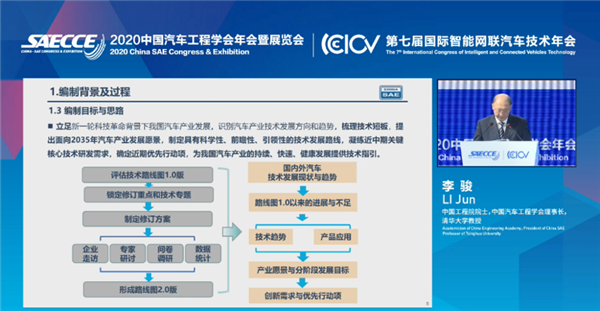NEVs, HEVs to each account for 50% of China new vehicle sales in 2035
Shanghai (Gasgoo)- Sales of new energy vehicles (NEVs) in China, the world's biggest auto market, will grow to 20% of overall new vehicle sales by 2025 from today's 5% and jump to 50% by 2035, the China Society of Automotive Engineers (China-SAE) said on October 27.

Dr. Li Jun is extending speech at the SAECCE 2020; photo credit: SAECCE 2020
According to China's policy, NEVs encompass BEVs (battery electric vehicles), PHEVs (plug-in hybrid vehicles) and FCVs (fuel cell vehicles).
The sales target is a key part of the 2.0 version of Technology Roadmap for Energy Saving and New Energy Vehicles (called “2.0 Roadmap” for short) announced by Li Jun, president of China-SAE, at the 2020 China SAE Congress & Exhibition (SAECCE 2020).
According to the 2.0 Roadmap, the carbon emission of the automotive industry will peak around 2028, ahead of the commitment China made for carbon emission reduction, and then dropped 20% by 2035 from the peak level.
The other five targets set for the next 15-year development of automotive technologies are as below:
1) The NEV will gradually become a mainstream vehicle product and the auto industry will basically complete its electrification transition.
2) Chinese-spec core technologies related to intelligent-connected vehicles (ICVs) will develop to a global leading level, and ICV-related products will be widely used.
3) The independence of core technology R&D will be significantly improved, and an efficient, safe and controllable industrial chain will be formed.
4) An automotive smart mobility system will be built, and an ecosystem integrating automobile, transportation, energy and city management systems will be established.
5) A technology innovation system will basically ripen, featuring cutting-edge original innovation capability.
The 2.0 Roadmap maps out how NEVs will go in China over the next 15 years. Li said the development of all-electric vehicles is still one of the key strategies China will adhere to. Based on the aforementioned targets, as of 2035, NEVs will account for 50% of China's annual new car sales, while BEVs will take over 95% share of the NEV market.
For the period of 2030 to 2035, the large-scale promotion and application of hydrogen energy and FCVs will be realized, and roughly 1 million FCVs will run on roads then. Moreover, developers in China will fully seize the core technologies of fuel cells, and a complete industrial chain for the preparation and production of fuel cell-related materials, parts and system will be set up.
The new roadmap also makes clear of the development goal for hybrid vehicles HEVs.
Sales of HEVs in China will jump to over 50% of overall traditional energy-fueled PV sales by 2025, to more than 75% by 2030, and to 100% by 2035. It indicates that the new vehicle sales in 2035 will be evenly occupied by NEVs and HEVs.
The balance development of diverse auto technologies and energy sources is more in tune with China's current national conditions, Wang Bingang, head of the National New Energy vehicle Innovation Project expert Group, said at the 2020 Global New Energy vehicle supply chain Innovation Conference in mid-September.
While boosting the electrification for automobiles, the transition of traditional cars should be equally prioritized. Thus, the expert panel considered China should pursue a shift to being fully electrified for traditional cars over the next 15 years, rather than entirely banning the sale of fossil fuel-powered vehicles.
Wang also noted “being fully electrified” will help eliminate the boundary between the technical systems of conventional cars and NEVs, and form a new holistic technology architecture and industrial chain deployment for China's auto industry.
On the whole, the 2.0 Roadmap will provide more options for car companies to reduce carbon emissions while insisting on the same strategic direction of electrification.
The 2.0 Roadmap also maps out the next steps in the domestic development of ICVs.
By 2025, the ICVs featuring partial automation and conditional automation will account for 50% of annual new vehicle sales, and the share will grow to 70% by 2030.
By 2035, highly automated vehicles will be largely deployed across China, and the Chinese-spec ICVs will deeply integrate with the systems of smart energy, intelligent transport and smart city. To be specific, highly automated ICVs will step into the market from 2025 and be widely deployed on highways in 2030. In 2035, highly automated and fully automated ICVs will feature the capabilities of decision-making and control by cooperating with other traffic participants.
By 2035, China will build a completely independent and well-controlled automotive industrial chain and the auto industry will fulfill its intelligence transition, said Dr. Li Jun. Meanwhile, the technology innovation system will be further perfected and the innovation capability will be substantially improved, which are favorable to forming a policy system that encourages the development of low-carbon solutions, auto intelligence and informatization, and building a comprehensive talent system, he added.
Gasgoo not only offers timely news and profound insight about China auto industry, but also help with business connection and expansion for suppliers and purchasers via multiple channels and methods. Buyer service:buyer-support@gasgoo.comSeller Service:seller-support@gasgoo.com







